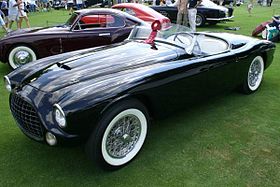Ferrari 212 Inter
| Ferrari 212 Inter | |
|---|---|
 | |
| Overview | |
| Manufacturer | Ferrari |
| Production | 1951–1952 82 produced |
| Designer | Carrozzeria Touring,[1]Pininfarina, Vignale, Ghia, Stabilimenti Farina |
| Body and chassis | |
| Class | Sports car |
| Layout | FR layout |
| Powertrain | |
| Engine | 2.6 L Colombo V12 |
| Chronology | |
| Predecessor | Ferrari 195 Inter |
| Successor | Ferrari 250 |
The Ferrari 212 Inter replaced Ferrari's successful 166 and 195 Inter grand tourers in 1951. Unveiled at the Brussels Motor Show that year, the 212 was an evolution of the 166 — a sports car for the road that could also win international races.
The chassis was similar to the 125 with a suspension featuring double wishbones in front and live axle in back. Coachbuilders included Carrozzeria Touring, Ghia, Ghia-Aigle, Vignale, Stabilimenti Farina, and now Pinin Farina. The latter was an important move for the company, as Farina was already well-known and adding his styling skills would be a tremendous boost for Maranello. However, Pinin Farina was as prideful as Enzo Ferrari, and neither would go to the other to request business up to this point. A mutual meeting halfway between Maranello and Turin was the negotiated solution.[2] First Ferrari to be bodied by Pinin Farina was 212 Inter Cabriolet, chassis no. 0177E.
The Inter's 2,600 mm (102.4 in) wheelbase was 4" longer than the 2,500 mm (98.4 in) Export's. The cars shared a larger, bored-out (68 mm) 2.6 L (2563 cc/156 in³) version of Ferrari's Colombo V12 engine. Output was 150 hp (111 kW) for the single Weber 36DCF carburetor Inter, 165 hp (123 kW) for the triple Weber Export. Improved cylinder heads raised power 5 hp (3.7 kW) in 1952.
The British magazine Autocar got hold of what they described as the first production model Ferrari 212 in 1950, which outperformed any car that they had previously tested.[3] It recorded a top speed of over 116 mph (187 km/h) and acceleration times of 0 to 60 mph (96 km/h) of 10.5 seconds[3] and 100 mph (161 km/h) in 22.5 seconds; the magazine however noted they had limited the engine to 6,500 rpm out of respect for the newness and low mileage of the car they were using, which suggested that even better performance would be available from a fully "run in" model. The test appears also to have been the Autocar team's first encounter with a five speed gear box.[3]
A single 212 Inter, chassis no. 0223EL2,[4] was fitted with the available "225" or 2.7 L Colombo V12, creating a unique model that would be properly referred to as a 225 Inter. This one-off model was given a Giovanni Michelotti penned berlinetta body built by Vignale.
Vignale's 212 show car from 1952

A 212 Inter Vignale at the Mille Miglia Storica
Another 212 Inter, chassis number 0253EU, also received the 2.7 liter three-carburetor V12, and was bodied as the last Barchetta by Carrozzeria Touring in their Superleggera construction method. It was acquired by Ford Motor Company for Henry Ford II for study in the research leading to the development of Ford's competitor to the Corvette, the Thunderbird. The car is currently in the collection of the Petersen Automotive Museum in Los Angeles, CA.
References
^ "Registro Internazionale Touring Superleggera". Retrieved November 11, 2012..mw-parser-output cite.citation{font-style:inherit}.mw-parser-output q{quotes:"""""""'""'"}.mw-parser-output code.cs1-code{color:inherit;background:inherit;border:inherit;padding:inherit}.mw-parser-output .cs1-lock-free a{background:url("//upload.wikimedia.org/wikipedia/commons/thumb/6/65/Lock-green.svg/9px-Lock-green.svg.png")no-repeat;background-position:right .1em center}.mw-parser-output .cs1-lock-limited a,.mw-parser-output .cs1-lock-registration a{background:url("//upload.wikimedia.org/wikipedia/commons/thumb/d/d6/Lock-gray-alt-2.svg/9px-Lock-gray-alt-2.svg.png")no-repeat;background-position:right .1em center}.mw-parser-output .cs1-lock-subscription a{background:url("//upload.wikimedia.org/wikipedia/commons/thumb/a/aa/Lock-red-alt-2.svg/9px-Lock-red-alt-2.svg.png")no-repeat;background-position:right .1em center}.mw-parser-output .cs1-subscription,.mw-parser-output .cs1-registration{color:#555}.mw-parser-output .cs1-subscription span,.mw-parser-output .cs1-registration span{border-bottom:1px dotted;cursor:help}.mw-parser-output .cs1-hidden-error{display:none;font-size:100%}.mw-parser-output .cs1-visible-error{font-size:100%}.mw-parser-output .cs1-subscription,.mw-parser-output .cs1-registration,.mw-parser-output .cs1-format{font-size:95%}.mw-parser-output .cs1-kern-left,.mw-parser-output .cs1-kern-wl-left{padding-left:0.2em}.mw-parser-output .cs1-kern-right,.mw-parser-output .cs1-kern-wl-right{padding-right:0.2em}
^ Enzo Ferrari and “Pinin” Farina: The birth of the myth. Archived 2009-08-17 at the Wayback Machine.
^ abc "Ferrari 212 Two-Seater (road test)". Autocar. Autocar Road test compendium 1950. 1950.
^ Ultimatecarpage.com
Ferrari road car timeline, 1947–1969 — next » | |||||||||||||||||||||||
|---|---|---|---|---|---|---|---|---|---|---|---|---|---|---|---|---|---|---|---|---|---|---|---|
Type |
1940s |
1950s |
1960s |
||||||||||||||||||||
| 7 | 8 | 9 |
0 | 1 | 2 | 3 | 4 | 5 | 6 | 7 | 8 | 9 |
0 | 1 | 2 | 3 | 4 | 5 | 6 | 7 | 8 | 9 |
|
Sports |
340 MM |
375 MM |
|||||||||||||||||||||
125 S |
166 S/166 MM |
195 S |
212 Export |
225 S |
250 MM |
250 Monza |
250 LM |
||||||||||||||||
159 S |
250 S |
250 Export |
250 GTO |
||||||||||||||||||||
Berlinetta |
250 GT "Tour de France" |
250 GT SWB |
250 GT Lusso |
275 GTB |
275 GTB/4 |
365 GTB/4 |
|||||||||||||||||
Coupé |
166 Inter |
195 Inter |
212 Inter |
250 Europa |
250 GT Europa |
250 GT Boano |
250 GT Ellena |
250 GT Coupé Pininfarina |
330 GTC |
365 GTC |
|||||||||||||
2+2 |
250 GT/E |
330 GT 2+2 |
365 GT 2+2 |
||||||||||||||||||||
Spider |
250 GT Cabriolet |
275 GTS |
330 GTS |
365 GTS |
|||||||||||||||||||
250 GT California Spyder | |||||||||||||||||||||||
America |
340/342 America |
375 America |
410 Superamerica |
400 Superamerica |
500 Superfast |
365 California |
|||||||||||||||||
| Wikimedia Commons has media related to Ferrari 212. |



Comments
Post a Comment